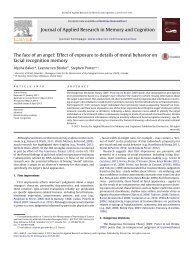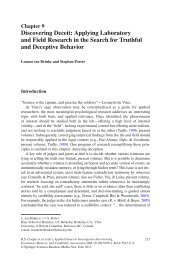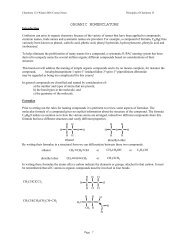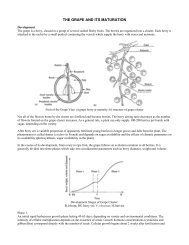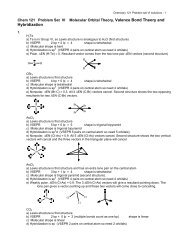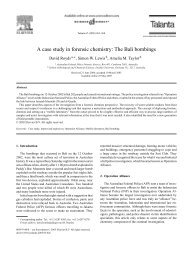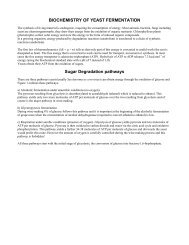Common Chemical Sense in Food Flavor Chemesthesis - People
Common Chemical Sense in Food Flavor Chemesthesis - People
Common Chemical Sense in Food Flavor Chemesthesis - People
Create successful ePaper yourself
Turn your PDF publications into a flip-book with our unique Google optimized e-Paper software.
<strong>Chemesthesis</strong><br />
<strong>Common</strong> <strong>Chemical</strong> <strong>Sense</strong> <strong>in</strong> <strong>Food</strong> <strong>Flavor</strong><br />
At first glance, most people th<strong>in</strong>k of the volatile or aromatic compounds perceived by the olfactory organs as the major<br />
contributors to flavor. Others would <strong>in</strong>clude the gustatory sense, that is, th<strong>in</strong>gs that are sweet, sour, salty, bitter, and perhaps<br />
umami, among the more important food flavors. In addition to the classical senses of taste and smell, anatomically separate<br />
systems <strong>in</strong> the mouth and nose provide additional sensory <strong>in</strong>put from chemical stimulation. Various tasteless and odorless<br />
compounds, such as carbon dioxide and capsaic<strong>in</strong>, are potent chemical stimuli and important flavor compounds <strong>in</strong> foods and<br />
beverages. Such stimuli are often classified as trigem<strong>in</strong>al because they are capable of stimulat<strong>in</strong>g nerve end<strong>in</strong>gs <strong>in</strong> the nose,<br />
mouth, and eyes that are subserved by branches of the fifth cranial nerves (the trigem<strong>in</strong>als). These nerves carry signals for<br />
pa<strong>in</strong>, touch, and temperature stimulation, and are generally associated with pa<strong>in</strong>ful or irritat<strong>in</strong>g chemical stimuli, hot pepper<br />
be<strong>in</strong>g a good example.<br />
However, other nerves, such as the glossopharyngeal nerve on the back of the tongue, also are capable of respond<strong>in</strong>g to<br />
irritative chemical stimulation. In fact, many sk<strong>in</strong> surfaces and mucous membranes can respond to chemical irritation if the<br />
compound is sufficiently potent. An example is the anal mucosa - an old Hungarian say<strong>in</strong>g states that paprika burns twice,<br />
and Indians say that you feel chili on the way out. For this reason, the old designation of such stimuli as trigem<strong>in</strong>al is los<strong>in</strong>g<br />
popularity, either to the even older designation of the “common chemical sense” or the newer term chemesthesis.<br />
<strong>Chemesthesis</strong> was derived for chemical stimuli <strong>in</strong> an analogy to somesthesis, the sensory system of the sk<strong>in</strong> that responds to<br />
touch (i.e., mechanical stimuli).<br />
Table 1 shows a breakdown of sensory systems subserv<strong>in</strong>g the complex of stimuli <strong>in</strong>volved <strong>in</strong> flavor. Taste, or oral<br />
chemical sensations, can be broken down <strong>in</strong>to the classical gustatory qualities and the oral chemesthetic sensations (e.g., hot<br />
pepper burn and menthol cool<strong>in</strong>g). Similarly, the nasal sensations from chemical stimulation can be divided <strong>in</strong>to true<br />
olfactory impressions and those that arise from stimulation of trigem<strong>in</strong>al nerve end<strong>in</strong>gs <strong>in</strong> the nose. Small reactive<br />
molecules such as carbon dioxide or isothiocyanates (from mustard) are good examples of chemesthetic flavors <strong>in</strong> the nose.<br />
However, many other traditionally olfactory stimuli may have trigem<strong>in</strong>al impact, especially at higher concentrations. In<br />
electrophysiological record<strong>in</strong>gs from animals, responses were observed from the trigem<strong>in</strong>al nerve to stimuli as benign as<br />
coffee aroma.<br />
Table 1: A scheme for the components of flavor based on anatomical considerations.<br />
<strong>Flavor</strong><br />
Oral Chemoreception<br />
Nasal Chemoreception<br />
“Taste”<br />
“Smell”<br />
Oral <strong>Chemical</strong><br />
Irritation<br />
Gustation Olfaction<br />
Trigem<strong>in</strong>al<br />
sensations, e.g.<br />
pepper heat<br />
Sweet, sour, salty, bitter, umami<br />
Sensations from volatiles, sniffed<br />
(“aroma”) or from the mouth –<br />
retronasally (“flavor”)<br />
Nasal <strong>Chemical</strong><br />
Irritation<br />
Trigem<strong>in</strong>al<br />
sensations, e.g.<br />
from carbon<br />
dioxide<br />
Volatile aromatic compounds, even when placed <strong>in</strong> the mouth, do not cause taste sensations but rather cause flavor<br />
sensations by retronasal passage through the posterior nasopharynx and up to the olfactory epithelium <strong>in</strong> the reverse<br />
direction from sniff<strong>in</strong>g. <strong>People</strong> who are mistakenly accustomed to speak<strong>in</strong>g of “taste thresholds” for volatile compounds<br />
such as citral can readily be conv<strong>in</strong>ced of their nearly complete olfactory impact by p<strong>in</strong>ch<strong>in</strong>g the nose closed while a<br />
solution is <strong>in</strong>troduced <strong>in</strong>to the mouth. This simple maneuver easily blocks retronasal passage by produc<strong>in</strong>g a dead air space<br />
<strong>in</strong> the nose and cuts off the alleged taste sensation. Releas<strong>in</strong>g the p<strong>in</strong>ched nostrils will cause a sudden impression of the<br />
lemon character of citral to develop.<br />
Somewhat more problematic <strong>in</strong> such a classification is the attribute of astr<strong>in</strong>gency. Astr<strong>in</strong>gent substances such as tann<strong>in</strong>s are<br />
clearly chemical stimuli, but their attendant sensations seem more tactile than flavorous. Astr<strong>in</strong>gency is def<strong>in</strong>ed as the<br />
complex of sensations due to shr<strong>in</strong>k<strong>in</strong>g, draw<strong>in</strong>g, or pucker<strong>in</strong>g of the epithelium as a result of exposure to substances such<br />
as alum or tann<strong>in</strong>s. Subjects seem to detect three component sensations with<strong>in</strong> the astr<strong>in</strong>gent complex: a dry<strong>in</strong>g sensation<br />
(lack of salivary lubrication); a rough<strong>in</strong>g sensation (usually perceived when the tongue comes <strong>in</strong> contact with other oral<br />
tissues such as the palate); and a draw<strong>in</strong>g or pucker<strong>in</strong>g sensation, which results from muscular tighten<strong>in</strong>g of the cheeks.
Because these sensations are tactile sensations of a chemical orig<strong>in</strong> and are mediated by anatomical systems outside the<br />
classical gustatory and olfactory nerves, they would seem to fall with<strong>in</strong> the boundary of the chemesthetic sensations.<br />
Chemesthetic <strong>Flavor</strong> Compounds<br />
Several dist<strong>in</strong>ct flavor impressions are mediated by chemesthetic sensory systems. These may be broadly grouped <strong>in</strong>to the<br />
follow<strong>in</strong>g categories:<br />
1. chemical irritation and pungency<br />
2. astr<strong>in</strong>gent materials<br />
3. cool<strong>in</strong>g compounds<br />
Pungent Materials<br />
A great deal is known about the chemical basis for pungent sensations because of their importance <strong>in</strong> various spices and<br />
flavor<strong>in</strong>gs. The structures of many pungent materials are known, particularly the components of spices, such as the families<br />
of capsaic<strong>in</strong>oids from red pepper and the piper<strong>in</strong>es and g<strong>in</strong>gerols from black pepper and g<strong>in</strong>ger, respectively. These<br />
compounds are sometimes referred to as produc<strong>in</strong>g oral chemical heat or more generically, irritation.<br />
By far the most thoroughly studied pungent compounds are the capsaic<strong>in</strong>oids. These are the active pr<strong>in</strong>ciples <strong>in</strong> so-called<br />
chilies, red pepper, paprika, and the like, conta<strong>in</strong>ed <strong>in</strong> the fruits of many pepper plants from the species Capsicum annuum<br />
(e.g., jalapeno peppers) and Capsicum frutescens (e.g., tabasco peppers).<br />
H 3 CO<br />
HO<br />
N<br />
H<br />
O<br />
capsaic<strong>in</strong><br />
Black pepper is the dried crushed seed of the southern Asian climb<strong>in</strong>g v<strong>in</strong>e Piper nigrum. White pepper comes from the<br />
decorticated kernel of the same plant. Both have the active compound piper<strong>in</strong>e.<br />
The active pungent compounds <strong>in</strong> g<strong>in</strong>ger are g<strong>in</strong>gerol and its derivatives.<br />
H 3 CO<br />
HO<br />
O<br />
O<br />
O<br />
O OH<br />
N<br />
piper<strong>in</strong>e<br />
g<strong>in</strong>gerol<br />
Other pungent substances <strong>in</strong>clude reactive sulfur-conta<strong>in</strong><strong>in</strong>g compounds, notably those <strong>in</strong> horseradish, mustard, onion, and<br />
garlic. Because of their volatility, it is unclear whether they should be classified as oral or nasal irritants. Probably, they can<br />
most reasonably be considered as both because the pungent sensations may be sensed throughout the mucosal tissues of the<br />
mouth as well as <strong>in</strong> the upper respiratory tract. Horseradish and mustard share the common family of isothiocyanates as<br />
pungent pr<strong>in</strong>ciples. These substances are bound as precursors <strong>in</strong> whole vegetables and are released through enzymatic action<br />
when the plant materials are ground. Allyl isothiocyanate, which occurs <strong>in</strong> both mustard and horseradish, is the most<br />
common member of this family. Brown mustards conta<strong>in</strong> 3-butenyl isothiocyanate.<br />
N<br />
C<br />
S<br />
allyl isothiocyanate C<br />
N<br />
S<br />
3-butenyl isothiocyanate<br />
The lacrimatory factor <strong>in</strong> onions appears to be different from the pungent pr<strong>in</strong>ciples. The reactive compound, propanethial<br />
S-oxide is produced from trans-(+)-S-(1-propenyl)-L-cyste<strong>in</strong>e sulfoxide.<br />
HO<br />
O<br />
S<br />
NH2 O<br />
trans-(+)-S-(1-propenyl)-L-cyste<strong>in</strong>e sulfoxide<br />
S O<br />
propanethial S-oxide
Astr<strong>in</strong>gent Factors<br />
Astr<strong>in</strong>gency has long been recognized as an important sensory attribute of many foods and beverages. In some historical<br />
classifications, astr<strong>in</strong>gency has been considered a primary or basic taste category, that is, equal <strong>in</strong> importance to the classical<br />
four taste qualities of sweet, sour, salty, and bitter. Others have classified astr<strong>in</strong>gency as a chemically <strong>in</strong>duced tactile<br />
sensation, a position that is supported by the tendency of astr<strong>in</strong>gent sensations to grow <strong>in</strong> <strong>in</strong>tensity with repeated<br />
stimulation, rather than show<strong>in</strong>g the adaptation that is characteristic of taste receptors.<br />
Astr<strong>in</strong>gents have been classified <strong>in</strong>to four ma<strong>in</strong> groups (25):<br />
1. salts of multivalent metallic cations (e.g., alum<strong>in</strong>um sulfate)<br />
2. dehydrat<strong>in</strong>g agents (e.g., ethanol and acetone)<br />
3. m<strong>in</strong>eral acids (<strong>in</strong>clud<strong>in</strong>g halogenated acetic acid)<br />
4. vegetable tann<strong>in</strong>s (e.g., grape seed tann<strong>in</strong> and tannic acid)<br />
The most common astr<strong>in</strong>gent compounds are the vegetable tann<strong>in</strong>s. Tann<strong>in</strong>s are water-soluble polyphenolic compounds that<br />
have the ability to precipitate alkaloids, gelat<strong>in</strong>, and other prote<strong>in</strong>s. The ecological function of these secondary plant<br />
metabolites is probably that of a deterrent to an animal who would consume the plant, either through unpleasant sensory<br />
characteristics or through undesirable post<strong>in</strong>gestional effects. Regard<strong>in</strong>g the undesirable post<strong>in</strong>gestional effect, high levels<br />
of tann<strong>in</strong>s <strong>in</strong> the diet can have deleterious nutritional effects as a result of b<strong>in</strong>d<strong>in</strong>g nutrients <strong>in</strong> the <strong>in</strong>test<strong>in</strong>al mucosa, which<br />
has a negative impact on the ability to absorb nutrients. <strong>Common</strong> foods and beverages with high amounts of tann<strong>in</strong>s <strong>in</strong>clude<br />
coffee, tea, beer, w<strong>in</strong>e, apples and ciders, many berry crops, and nuts.<br />
Although moderate degrees of astr<strong>in</strong>gent sensations contribute to the palatability of some foods <strong>in</strong> which they are expected<br />
(e.g., red w<strong>in</strong>es), <strong>in</strong> other foods they are considered flavor defects, such as <strong>in</strong> fluid milk and other dairy products.<br />
Cool<strong>in</strong>g Compounds<br />
Sensations of coolness are important <strong>in</strong> consumer products such as cigarettes, chew<strong>in</strong>g gum, candy, toothpaste, mouthwash,<br />
l<strong>in</strong>iments, and pharmaceuticals. The substance most often associated with this cool<strong>in</strong>g sensation is menthol. It is the ma<strong>in</strong><br />
component <strong>in</strong> a number of pepperm<strong>in</strong>t oils obta<strong>in</strong>ed from Mentha piperita and Mentha arasis.<br />
OH<br />
(-)-Menthol



